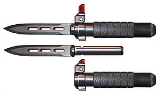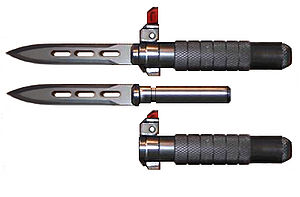
Ballistic knife
Encyclopedia

Combat knife
A combat knife is a fighting knife designed solely for military use and primarily intended for hand-to-hand or close combat fighting.Since the end of trench warfare, most military combat knives have been secondarily designed for utility use in addition to their original role as close-quarter combat...
with a detachable gas- or spring-propelled blade
Blade
A blade is that portion of a tool, weapon, or machine with a cutting edge and/or a pointed tip that is designed to cut and/or puncture, stab, slash, chop, slice, thrust, or scrape animate or inanimate surfaces or materials...
that can be fired to a distance of several feet or meters by pressing a trigger or switch on the handle.
History and usage
Ballistic or 'firing knives' are believed to have first appeared as part of the equipment issued to Soviet and Eastern Bloc special forcesSpecial forces
Special forces, or special operations forces are terms used to describe elite military tactical teams trained to perform high-risk dangerous missions that conventional units cannot perform...
formations, such as the Soviet Voyska specialnogo naznacheniya, or Spetsnaz
Spetsnaz
Spetsnaz, Specnaz tr: Voyska specialnogo naznacheniya; ) is an umbrella term for any special forces in Russian, literally "force of special purpose"...
. By 1985, spring-powered ballistic knives were being advertised for sale in the United States in the Shotgun News, Soldier of Fortune
Soldier of Fortune (magazine)
Soldier of Fortune , The Journal of Professional Adventurers, is a periodical monthly magazine devoted to world-wide reporting of wars, including conventional warfare, low-intensity warfare, counter insurgency, and counter-terrorism...
, and other publications.
Ballistic knives were originally intended by Soviet military planners to be an improvement on teaching the skill of knife throwing as basic training to new Spetsnaz trainees. The vast numbers of men recruited into the armed forces of the Soviet Union resulted in restrictions on available training time, even for elite forces, and knife throwing required many hours of training and practice. The ballistic knife, which was relatively easy to operate and manufacture, required much less practice than learning to throw a knife by hand. Its primary advantage was the element of surprise. The blade can remain attached to the handle and used as a typical fixed-blade combat knife or launched as a projectile by pulling a pin and pressing a button.
In its spring-propelled form, the blade of a ballistic knife is theoretically capable of being fired to an effective range of around 5 meters (about 16 feet) at a speed of 63 km/h (39 mph). Ballistic knives using compressed air or gas propulsion to fire the blade can be made somewhat more powerful, and do not suffer from spring fatigue over time. However, since the projectile blade of most ballistic knives has no aerodynamic or gyroscopic stabilization, the blade frequently tumbles after traveling a short distance. While easier to learn than the skill of knife throwing, the jarring shock caused by unleashing the expanding spring and a lack of a sighting mechanism contributed to its inaccuracy, making it advisable to close to within a few feet to ensure the blade delivered a killing blow to a targeted and vulnerable area of the body. Soviet training doctrine of the day emphasized the use of the thrown knife as a silent weapon, designed to kill or incapacitate an unsuspecting opponent at just beyond grappling distance (five to six paces); the ballistic knife appears to fit within that tactical doctrine.
Legality in the United Kingdom
The legal status of ballistic knives or pilum knives is doubtful under current legislation in the United Kingdom, particularly given the degree of discretion granted to Crown prosecutors and police with regard to knife possession offenses. Prosecutors are encouraged by the government to charge defendants under more than one Act where applicable.The marketing, sale, transfer, or possession in a public place of a ballistic knife could be construed to be illegal under the Restriction of Offensive Weapons Act 1959, the Knives Act 1997, the Criminal Justice Act 1988, and the Prevention of Crime Act 1953. The Restriction of Offensive Weapons Act 1959 imposes criminal penalties for anyone who manufactures, sells or hires, or offers for sale or hire, or lends or gives to any other person "any knife which has a blade which opens automatically by hand pressure applied to a button, spring or other device in or attached to the handle of the knife." The Knives Act 1997 prohibits the marketing of knives as offensive weapons, while the Criminal Justice Act 1988 prohibits the carrying of blades or sharply pointed objects in a public place without "good reason or lawful authority". Finally, the Prevention of Crime Act 1953 prohibits the possession in any public place of an offensive weapon without "lawful authority or reasonable excuse." The term "offensive weapon" is defined under the Prevention of Crime Act 1953 as: "any article made or adapted for use to causing injury to the person, or intended by the person having it with him for such use". Under the Prevention of Crime Act, knives otherwise 'exempt' from penalty under the Criminal Justice Act 1988 when carried for "good reason or lawful authority" may still be deemed illegal if authorities conclude the knife is being carried as an "offensive weapon" without "lawful authority or reasonable excuse". 'Lawful authority’ means those occasions where people from time to time are required to carry weapons as a matter of governmental duty, such as police officers or members of the armed forces, not private persons, hence the 'lawful authority' language cannot be relied upon to establish an exemption from prosecution of private individuals. Furthermore, as the ballistic knife was originally designed as an offensive weapon, not as a tool intended for use in a trade or business, and given current prosecutorial directives, it may be difficult to establish "reasonable excuse" for such a knife before a UK prosecutor or court, especially as the carrying of a knife in public for self-defence is not acceptable as a "reasonable excuse". In the eyes of the law, claims of self-protection are presently viewed as an admission that the defendant intends to use the knife in violation of the law as an "offensive weapon" - albeit in a defensive manner, and in otherwise justifiable circumstances.
History of legislation
After hearing uncorroborated testimony from a congressional witnesss that ballistic knives could be used to defeat body armorPersonal armor
Personal armor is the whole of protecting clothing, designed to absorb and/or deflect slashing, bludgeoning, and penetrating attacks. They were historically used to protect soldiers, whereas today, they are also used to protect police forces, private citizens and private security guards or...
typically worn by police officers, and witnessing a staged demonstration against a wood-backed target, Senator Alphonse D'Amato of New York introduced the Ballistic Knife Prohibition Act, a bill to ban sale or possession of ballistic knives. The bill eventually failed. However, after gaining the support of Senators Strom Thurmond
Strom Thurmond
James Strom Thurmond was an American politician who served as a United States Senator. He also ran for the Presidency of the United States in 1948 as the segregationist States Rights Democratic Party candidate, receiving 2.4% of the popular vote and 39 electoral votes...
of South Carolina, and Dennis DeConcini
Dennis DeConcini
Dennis Webster DeConcini is a former Democratic U.S. Senator from Arizona. Son of former Arizona Supreme Court Judge Evo Anton DeConcini, he represented Arizona in the United States Senate from 1977 until 1995....
of Arizona, congressional support for a ban on import or possession of ballistic knives quickly gained traction. In September 1986 senators supporting the ballistic knife ban attached their bill to popular legislation designed to eradicate drug crops in foreign countries and halt international drug trafficking operations. The bill was subsequently enacted into law. The new federal statute prohibited future importation or possession of such knives in interstate commerce. Some individual states following the example set by the federal law and passed even tighter restrictions, sometimes banning ownership of the knives outright within their state.
Current law
Similar to conventional automatic knivesSwitchblade
A switchblade is a type of knife with a folding or sliding blade contained in the handle which is opened automatically by a spring when a button, lever, or switch on the handle or bolster is activated A switchblade (also known as an automatic knife, pushbutton knife, switch, Sprenger, Springer,...
, federal law makes ballistic knives with a spring-operated blade illegal to possess, manufacture, sell, or import "in or affecting interstate commerce." This means they are illegal to import from outside the US, as well as buy or sell over state lines, including possessing or making them with intent to sell over state lines. The federal law also makes it a separate crime to use or possess a ballistic knife during the commission of a federal crime
Federal crime
In the United States, a federal crime or federal offense is a crime that is made illegal by U.S. federal legislation. In the United States, criminal law and prosecution happen at both the federal and the state levels; thus a “federal crime” is one that is prosecuted under federal criminal law, and...
of violence
Violent crime
A violent crime or crime of violence is a crime in which the offender uses or threatens to use violent force upon the victim. This entails both crimes in which the violent act is the objective, such as murder, as well as crimes in which violence is the means to an end, such as robbery. Violent...
, with a minimum sentence of 5 years in a federal prison. Federal law does not prohibit the possession, manufacture, or sale of a ballistic knife within a state's boundaries, and the individual laws of each state or territory must be consulted to determine whether possession, manufacture, or sale within a given state is legal (many states have statutes that regulate or prohibit the acquisition and/or possession of ballistic knives, and penalties vary from state to state). Like the federal switchblade
Switchblade
A switchblade is a type of knife with a folding or sliding blade contained in the handle which is opened automatically by a spring when a button, lever, or switch on the handle or bolster is activated A switchblade (also known as an automatic knife, pushbutton knife, switch, Sprenger, Springer,...
law, an exception is made for sale to the US Armed Forces within the confines of a contract, as well as possession by duly-authorized members of the Armed Forces in performance of their duty.
A ballistic knife with a blade propelled by an explosive charge is legal to own under federal law, as it is deemed a firearm under the AOW (Any Other Weapons) category of the NFA.

